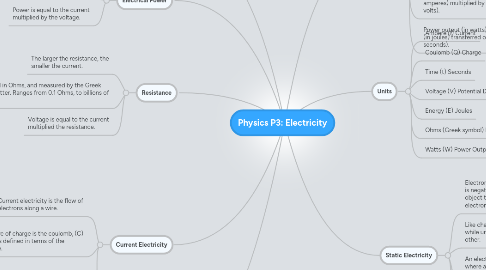Physics P3: Electricity
Phillip CONRADにより

1. Potential Difference and Electromotive Force
1.1. Potential difference is a measure of energy in each charge flowing in a wire.
1.2. Potential difference is measured in volts, and measured by a voltmeter.
1.2.1. Voltage is equal to the energy (in joules) divided by the charge (in coulombs)
1.2.2. Voltmeters are always connected in paralell
1.3. Electromotive force (EMF) is another term that is used to denote a voltage. EMF is used to describe the energy per unit charge driving current around a circuit, whereas a potential difference is the energy per unit charge diving current between any two points in a circuit.
2. Current Electricity
2.1. Current electricity is the flow of electrons along a wire.
2.2. Measure of charge is the coulomb, (C) and it is defined in terms of the ampere.
2.2.1. Q=IxT
2.2.1.1. Charge is equal to current times time.
2.2.2. The charge of Six times 10^18 electrons equals one coulomb
2.3. The unit of current is an ampere (A), which is measured by an ammeter.
3. Resistance
3.1. The larger the resistance, the smaller the current.
3.2. Measured in Ohms, and measured by the Greek Omega letter. Ranges from 0.1 Ohms, to billions of ohms.
3.3. Voltage is equal to the current multiplied the resistance.
4. Electrical Power
4.1. Power is measured in watts, or also joules per second.
4.2. Power is equal to the current multiplied by the voltage.
5. Misc.
5.1. Energy (in joules) is equal to the voltage, current, and time all multiplied.
5.2. Energy can be thought of as power multiplied by time.
6. Static Electricity
6.1. Electrons captured carry negative charge, so an object that is negatively charged has an excess of electrons, while an object that is positively charged has a shortage of electrons.
6.2. Like charges repel each other, while unlike charges attract each other.
6.3. An electric field is a region where an electric charge feels a force.
6.4. Objects can be charged by rubbing. This is not due to the creation of electrons, but the transferral of electrons from one material to another.
6.5. Charge is a property of matter.
7. Laws
7.1. Charge (in Coulombs) is equal to the current (in amperes) times time (in seconds).
7.2. Potential Difference (in volts) is equal to the energy (joules) over charge (in coulombs).
7.3. Potential Difference (In volts) is equal to the current (in amperes) multiplied by the resistance (in ohms).
7.4. Energy (in joules) is equal to the potential difference multiplied by the current (in amperes) and the time (in seconds).
7.5. Power output (in watts) is equal to the current (in amperes) multiplied by the potential difference (in volts).
7.6. Power output (in watts) is equal to the energy (in joules) transferred over time taken (in seconds).
8. Units
8.1. Ampere (I) Current
8.2. Coulomb (Q) Charge
8.3. Time (t) Seconds
8.4. Voltage (V) Potential Difference
8.5. Energy (E) Joules
8.6. Ohms (Greek symbol) Resistance
8.7. Watts (W) Power Output



